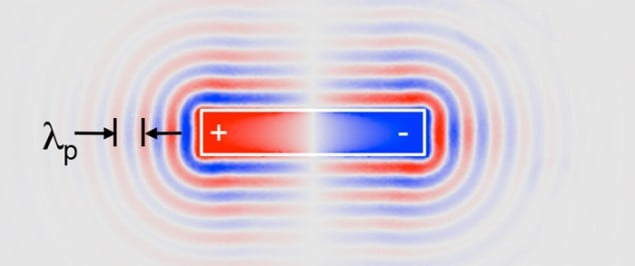
A simple way of creating and controlling surface plasmon polaritons (SPPs) in graphene has been demonstrated by researchers in Spain and Argentina. SPPs are quasiparticles that are a hybrid of light and electrons, and the new technique involves using simple gold antennas to channel light energy into the material. The research could lead to the development of new electronic devices that use light.
SPPs are quasiparticles that are combined oscillations of photons and mobile charge carriers, such as electrons. Although they can be excited in metals, they propagate much further in graphene, so several groups are studying the potential of graphene plasmonics as an interface between optical and electronic circuits and devices. One important benefit of SPPs is that their wavelengths are much shorter than visible light, which means that devices based on SPPs can be made much smaller than those based on light. However, there is also a downside: the wavelength of a plasmon in doped graphene is much shorter than that of an incident photon of the same frequency, making the SPP’s momentum much larger. For an incident photon to excite a plasmon in bare graphene would, therefore, violate Newton’s third law, which requires momentum to be conserved.
Channelling momentum
In 2012 researchers in Spain led by Rainer Hillenbrand at CIC nanoGUNE in Donostia-San Sebastian and Frank Koppens at the Institute for Photonic Sciences in Barcelona, in parallel with an independent group in the US, created and imaged SPPs in graphene using a near-field optical microscope. They achieved this using near-field (or evanescent) light, which extends only a very short distance from a surface but can carry very high momentum. By bringing the tip of the microscope – which is a source of evanescent light – very close to the graphene, the researchers could channel much more momentum to the graphene than would otherwise have been possible. Using the same microscope tip, they also imaged reflected SPPs and recorded interference patterns.
Now the Spanish group has found a simpler, more practicable way to excite and control graphene plasmons, which could be useful for future engineering applications. The researchers covered the graphene with tiny gold antennas (bars about 3 μm long) that absorb photons at a particular frequency. This creates an optical dipole in the antenna that, in turn, creates evanescent light. As the antenna is in direct contact with the graphene, energy from the near field creates SPPs in the graphene. By changing the size of the antenna, the frequency of light absorbed can be altered. This changes the frequency of the SPPs that are produced.
Focus and diffraction
The researchers manipulated the SPPs in various ways. For example, a straight antenna launched planar SPP waves, but the team also managed to focus SPPs to a point by using an antenna with a concave tip. They also demonstrated refraction of the SPPs using a 2D “prism” of bilayer graphene. The bilayer graphene has higher electrical conductivity than the monolayer graphene, so the wavelength lengthens inside the prism and the SPPs bend away from the normal according to Snell’s law. In the future, the researchers believe the bilayer should not be necessary. “One could simply apply a gate voltage on a small area of the graphene,” explains Hillenbrand, “and then one could actually tune the wavelength inside the prism to control the refraction angle. That is nearly impossible to do with other materials.” If this could be achieved, it would open the way for a plasmonic transistor, in which a gate voltage could switch a plasmon current on and off.
Before such manipulations can be achieved, however, the team needs to improve the distance SPPs can propagate through the graphene, which at present is limited to 1–2 μm. The researchers are now working to boost the SPP’s range by using higher-quality graphene and looking for ways to dope it more highly, so it has more free electrons. “If one has achieved that,” says Hillenbrand, “I could imagine that these waves should propagate at least one order of magnitude further.”
Graphene expert
Alexander Grigorenko at the University of Manchester says that the work is not only a significant scientific achievement in the degree of control that the researchers have achieved over the graphene SPPs, but also a major technological one in the precision with which they have observed them using a new type of near-field microscope. “I would say there are just two labs in the world that could do something like what they’ve done right now,” he says. “If you talk about long-term importance: who knows?”
The research is published in Science.



